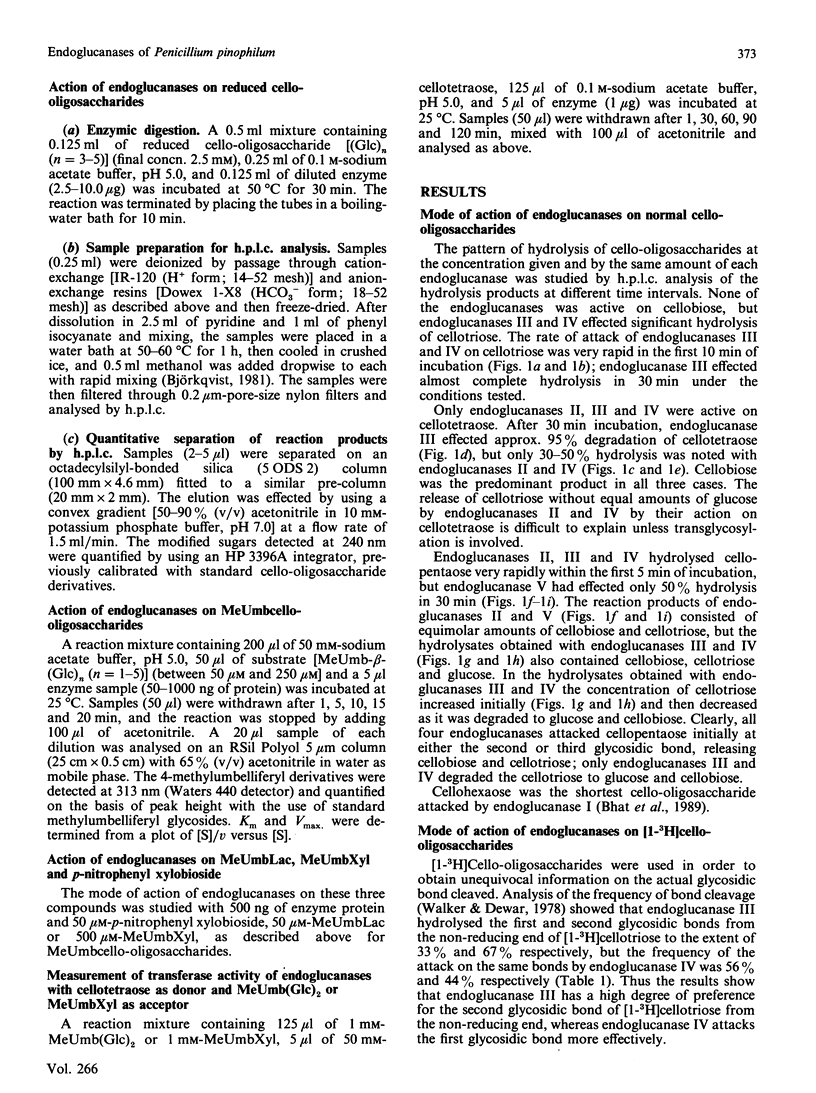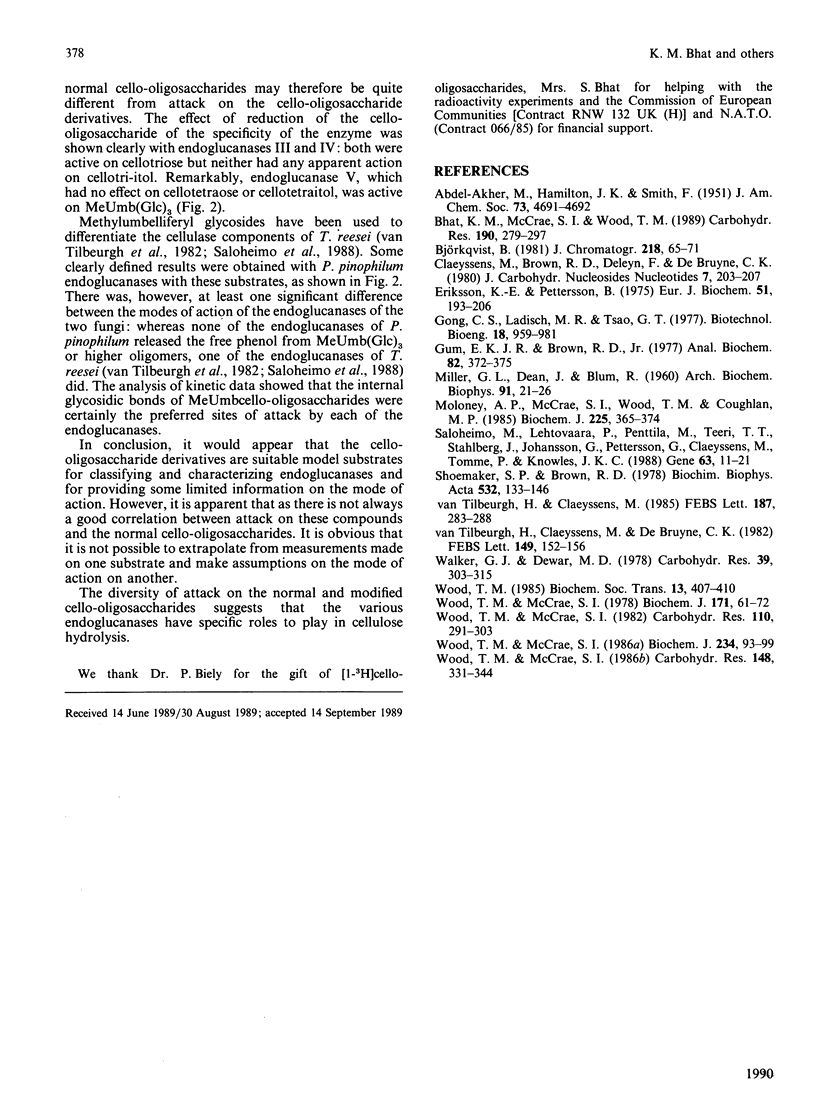Abstract
The modes of action of the five major endo-(1----4)-beta-D-glucanases (I, II, III, IV and V) purified from Penicillium pinophilum cellulase were compared by h.p.l.c. analysis, with normal, 1-3H-labelled and reduced cello-oligosaccharides and 4-methylumbelliferyl glycosides as substrates. Significant differences were observed in the preferred site of cleavage even when substrates with the same number of glycosidic bonds were compared. Thus, although endoglucanase I was unable to attack normal cello-oligosaccharides shorter than degree of polymerization 6, it hydrolysed reduced cellopentaose to yield cellotriose and cellobi-itol, and it produced cellotriose and 4-methylumbelliferyl glucoside from 4-methylumbelliferyl cellotetraoside. Endoglucanase IV hydrolysed [1-3H]cellotriose but did not attack either cellotri-itol or 4-methylumbelliferyl cellobioside. These and other anomalous results indicated clearly that modification of the reducing glycosyl residue on the cello-oligosaccharides induces in an apparent change in the mode of action of the endoglucanases. It is suggested that, although cello-oligosaccharide derivatives are useful for differentiating and classifying endoglucanases, conclusions on the mechanism of cellulase action resulting from these measurements should be treated cautiously. Unequivocal information on the mode of endoglucanase action on cello-oligosaccharides was obtained with radiolabelled cello-oligosaccharides of degree of polymerization 3 to 5. Indications that transglycosylation was a property of the endoglucanases were particularly evident with the 4-methylumbelliferyl cello-oligosaccharides. Turnover numbers for hydrolysis of the umbelliferyl cello-oligosaccharides were calculated, and these, along with the other analytical data collected on the products of hydrolysis of the normal, reduced and radiolabelled cello-oligosaccharides, suggested that the various endoglucanases had different roles to play in the overall hydrolysis of cellulose to sugars small enough to be transported through the cell membrane.
Full text
PDF







Selected References
These references are in PubMed. This may not be the complete list of references from this article.
- Eriksson K. E., Pettersson B. Extracellular enzyme system utilized by the fungus Sporotrichum pulverulentum (Chrysosporium lignorum) for the breakdown of cellulose. 1. Separation, purification and physico-chemical characterization of five endo-1,4-beta-glucanases. Eur J Biochem. 1975 Feb 3;51(1):193–206. doi: 10.1111/j.1432-1033.1975.tb03919.x. [DOI] [PubMed] [Google Scholar]
- Gong C. S., Ladisch M. R., Tsao G. T. Cellobiase from Trichoderma viride: purification, properties, kinetics, and mechanism. Biotechnol Bioeng. 1977 Jul;19(7):959–981. doi: 10.1002/bit.260190703. [DOI] [PubMed] [Google Scholar]
- Gum E. K., Jr, Brown R. D., Jr Two alternative HPLC separation methods for reduced and normal cellooligosaccharides. Anal Biochem. 1977 Oct;82(2):372–375. doi: 10.1016/0003-2697(77)90174-9. [DOI] [PubMed] [Google Scholar]
- Moloney A. P., McCrae S. I., Wood T. M., Coughlan M. P. Isolation and characterization of the 1,4-beta-D-glucan glucanohydrolases of Talaromyces emersonii. Biochem J. 1985 Jan 15;225(2):365–374. doi: 10.1042/bj2250365. [DOI] [PMC free article] [PubMed] [Google Scholar]
- Saloheimo M., Lehtovaara P., Penttilä M., Teeri T. T., Ståhlberg J., Johansson G., Pettersson G., Claeyssens M., Tomme P., Knowles J. K. EGIII, a new endoglucanase from Trichoderma reesei: the characterization of both gene and enzyme. Gene. 1988;63(1):11–22. doi: 10.1016/0378-1119(88)90541-0. [DOI] [PubMed] [Google Scholar]
- Shoemaker S. P., Brown R. D., Jr Enzymic activities of endo-1,4-beta-D-glucanases purified from Trichoderma viride. Biochim Biophys Acta. 1978 Mar 14;523(1):133–146. doi: 10.1016/0005-2744(78)90016-5. [DOI] [PubMed] [Google Scholar]
- Walker G. J., Dewar M. D. The action pattern of Penicillium lilacinum dextranase. Carbohydr Res. 1975 Feb;39(2):303–315. doi: 10.1016/s0008-6215(00)86140-6. [DOI] [PubMed] [Google Scholar]
- Wood T. M., McCrae S. I. The cellulase of Penicillium pinophilum. Synergism between enzyme components in solubilizing cellulose with special reference to the involvement of two immunologically distinct cellobiohydrolases. Biochem J. 1986 Feb 15;234(1):93–99. doi: 10.1042/bj2340093. [DOI] [PMC free article] [PubMed] [Google Scholar]
- Wood T. M., McCrae S. I. The cellulase of Trichoderma koningii. Purification and properties of some endoglucanase components with special reference to their action on cellulose when acting alone and in synergism with the cellobiohydrolase. Biochem J. 1978 Apr 1;171(1):61–72. doi: 10.1042/bj1710061. [DOI] [PMC free article] [PubMed] [Google Scholar]
- Wood T. M. Properties of cellulolytic enzyme systems. Biochem Soc Trans. 1985 Apr;13(2):407–410. doi: 10.1042/bst0130407. [DOI] [PubMed] [Google Scholar]


